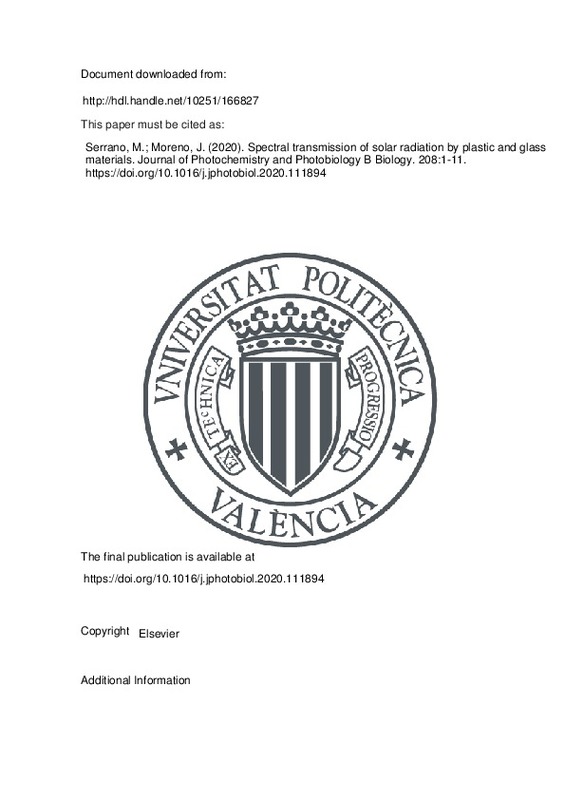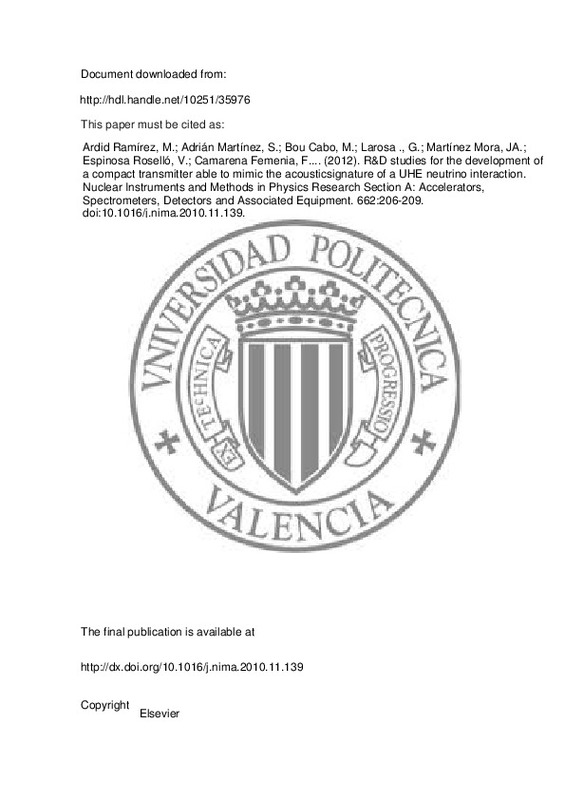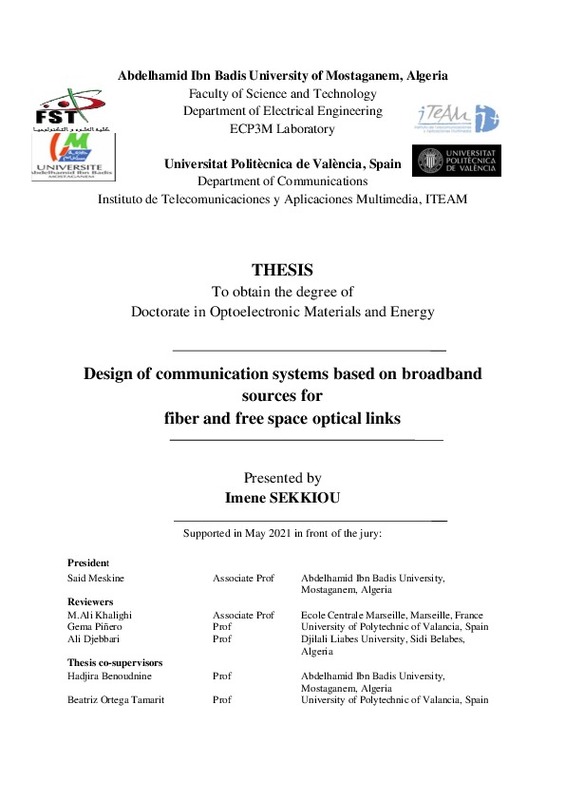JavaScript is disabled for your browser. Some features of this site may not work without it.
Buscar en RiuNet
Listar
Mi cuenta
Estadísticas
Ayuda RiuNet
Admin. UPV
Spectral transmission of solar radiation by plastic and glass materials
Mostrar el registro sencillo del ítem
Ficheros en el ítem
| dc.contributor.author | Serrano, María-Antonia
|
es_ES |
| dc.contributor.author | Moreno, J.C.
|
es_ES |
| dc.date.accessioned | 2021-05-27T03:34:02Z | |
| dc.date.available | 2021-05-27T03:34:02Z | |
| dc.date.issued | 2020-07 | es_ES |
| dc.identifier.issn | 1011-1344 | es_ES |
| dc.identifier.uri | http://hdl.handle.net/10251/166827 | |
| dc.description.abstract | [EN] It is well known that excessive exposure to solar ultraviolet (UV) radiation can have serious adverse effects. Many everyday materials influence the UV radiation received by humans, for example, those used in construction and on the exterior of buildings such as plastics and glass can reduce the UV exposure of persons exposed to solar radiation. In this paper we analyse the spectral transmission of solar radiation of widely used materials using the transmittance parameter. The measurements were performed on clear days, at 8 h and 12 solar hours, in July 2018 (five days) and in January 2019 (three days). The spectral transmittances of these materials and the integrated transmittances in the UVB from 300 nm, UVA, visible (VIS) and near infrared ranges (NIR) were calculated. In summer in the UVB range from 300 nm methacrylate and smoked glass have the highest transmittance values (56%) and polycarbonate present the lowest (30%). In the VIS and NIR ranges methacrylate (95%) and smoked glass (80%) have the highest transmittances and polycarbonate the lowest (45%). In general the 8 h transmittances are higher than those at 12 h and are also higher in winter than summer. For two biological functions (erythemal and DNA-damage) and for the UVB range from 300 nm, the transmittance for most materials (except fibreglass) is in the range 6-14%. The exposure times obtained show that erythemal damage could occur after long exposure to solar radiation through the materials studied, information which should be made available to the general public. | es_ES |
| dc.description.sponsorship | The authors wish to thank the Generalitat Valenciana for providing us with access to weather data. | es_ES |
| dc.language | Inglés | es_ES |
| dc.publisher | Elsevier | es_ES |
| dc.relation.ispartof | Journal of Photochemistry and Photobiology B Biology | es_ES |
| dc.rights | Reconocimiento - No comercial - Sin obra derivada (by-nc-nd) | es_ES |
| dc.subject | Spectral transmittance | es_ES |
| dc.subject | UVA transmittance | es_ES |
| dc.subject | UVB transmittance | es_ES |
| dc.subject | VIS transmittance | es_ES |
| dc.subject | NIR transmittance | es_ES |
| dc.subject | Erythemal transmittance | es_ES |
| dc.subject.classification | FISICA APLICADA | es_ES |
| dc.title | Spectral transmission of solar radiation by plastic and glass materials | es_ES |
| dc.type | Artículo | es_ES |
| dc.identifier.doi | 10.1016/j.jphotobiol.2020.111894 | es_ES |
| dc.rights.accessRights | Abierto | es_ES |
| dc.contributor.affiliation | Universitat Politècnica de València. Departamento de Física Aplicada - Departament de Física Aplicada | es_ES |
| dc.description.bibliographicCitation | Serrano, M.; Moreno, J. (2020). Spectral transmission of solar radiation by plastic and glass materials. Journal of Photochemistry and Photobiology B Biology. 208:1-11. https://doi.org/10.1016/j.jphotobiol.2020.111894 | es_ES |
| dc.description.accrualMethod | S | es_ES |
| dc.relation.publisherversion | https://doi.org/10.1016/j.jphotobiol.2020.111894 | es_ES |
| dc.description.upvformatpinicio | 1 | es_ES |
| dc.description.upvformatpfin | 11 | es_ES |
| dc.type.version | info:eu-repo/semantics/publishedVersion | es_ES |
| dc.description.volume | 208 | es_ES |
| dc.identifier.pmid | 32450467 | es_ES |
| dc.relation.pasarela | S\422153 | es_ES |
| dc.description.references | Sklar, L. R., Almutawa, F., Lim, H. W., & Hamzavi, I. (2013). Effects of ultraviolet radiation, visible light, and infrared radiation on erythema and pigmentation: a review. Photochem. Photobiol. Sci., 12(1), 54-64. doi:10.1039/c2pp25152c | es_ES |
| dc.description.references | Greinert, R., de Vries, E., Erdmann, F., Espina, C., Auvinen, A., Kesminiene, A., & Schüz, J. (2015). European Code against Cancer 4th Edition: Ultraviolet radiation and cancer. Cancer Epidemiology, 39, S75-S83. doi:10.1016/j.canep.2014.12.014 | es_ES |
| dc.description.references | Bais A, Topaloglou C, Kazadtzis S, et al. Report of the LAP/COST/WMO Intercomparison of Erythemal Radiometers, Thessaloniki, Greece, 13–23 September 1999, 2001 WMO-GAW report No. 141 (WHO TD No. 1051) Geneva. | es_ES |
| dc.description.references | Lucas, R. M., Yazar, S., Young, A. R., Norval, M., de Gruijl, F. R., Takizawa, Y., … Neale, R. E. (2019). Human health in relation to exposure to solar ultraviolet radiation under changing stratospheric ozone and climate. Photochemical & Photobiological Sciences, 18(3), 641-680. doi:10.1039/c8pp90060d | es_ES |
| dc.description.references | Parisi, A. V., & Wong, J. C. F. (1998). Quantitative evaluation of the personal erythemal ultraviolet exposure in a car. Photodermatology, Photoimmunology & Photomedicine, 14(1), 12-16. doi:10.1111/j.1600-0781.1998.tb00003.x | es_ES |
| dc.description.references | Kimlin, M. G., & Parisi, A. V. (1999). Ultraviolet radiation penetrating vehicle glass: a field based comparative study. Physics in Medicine and Biology, 44(4), 917-926. doi:10.1088/0031-9155/44/4/008 | es_ES |
| dc.description.references | M., K., A., P., B., C., & D., T. (2002). Comparison of the solar spectral ultraviolet irradiance in motor vehicles with windows in an open and closed position. International Journal of Biometeorology, 46(3), 150-156. doi:10.1007/s00484-002-0131-5 | es_ES |
| dc.description.references | Tuchinda, C., Srivannaboon, S., & Lim, H. W. (2006). Photoprotection by window glass, automobile glass, and sunglasses. Journal of the American Academy of Dermatology, 54(5), 845-854. doi:10.1016/j.jaad.2005.11.1082 | es_ES |
| dc.description.references | Cadet, J., Grand, A., & Douki, T. (2014). Solar UV Radiation-Induced DNA Bipyrimidine Photoproducts: Formation and Mechanistic Insights. Topics in Current Chemistry, 249-275. doi:10.1007/128_2014_553 | es_ES |
| dc.description.references | Mouret, S., Forestier, A., & Douki, T. (2012). The specificity of UVA-induced DNA damage in human melanocytes. Photochem. Photobiol. Sci., 11(1), 155-162. doi:10.1039/c1pp05185g | es_ES |
| dc.description.references | Sage, E., Girard, P.-M., & Francesconi, S. (2012). Unravelling UVA-induced mutagenesis. Photochem. Photobiol. Sci., 11(1), 74-80. doi:10.1039/c1pp05219e | es_ES |
| dc.description.references | Battie, C., Jitsukawa, S., Bernerd, F., Del Bino, S., Marionnet, C., & Verschoore, M. (2014). New insights in photoaging, UVA induced damage and skin types. Experimental Dermatology, 23, 7-12. doi:10.1111/exd.12388 | es_ES |
| dc.description.references | Parisi, A. V., & Turnbull, D. J. (2014). Shade Provision for UV Minimization: A Review. Photochemistry and Photobiology, 90(3), 479-490. doi:10.1111/php.12237 | es_ES |
| dc.description.references | Gies, P., Makin, J., Dobbinson, S., Javorniczky, J., Henderson, S., Guilfoyle, R., & Lock, J. (2013). Shade Provision for Toddlers at Swimming Pools in Melbourne. Photochemistry and Photobiology, 89(4), 968-973. doi:10.1111/php.12078 | es_ES |
| dc.description.references | Li, D., Li, Z., Zheng, Y., Liu, C., & Lu, L. (2015). Optical performance of single and double glazing units in the wavelength 337–900 nm. Solar Energy, 122, 1091-1099. doi:10.1016/j.solener.2015.10.028 | es_ES |
| dc.description.references | Liu, C., Wu, Y., Zhu, Y., Li, D., & Ma, L. (2018). Experimental investigation of optical and thermal performance of a PCM-glazed unit for building applications. Energy and Buildings, 158, 794-800. doi:10.1016/j.enbuild.2017.10.069 | es_ES |
| dc.description.references | Milon, A., Sottas, P.-E., Bulliard, J.-L., & Vernez, D. (2006). Effective exposure to solar UV in building workers: influence of local and individual factors. Journal of Exposure Science & Environmental Epidemiology, 17(1), 58-68. doi:10.1038/sj.jes.7500521 | es_ES |
| dc.description.references | Gies, P., & Wright, J. (2003). Measured Solar Ultraviolet Radiation Exposures of Outdoor Workers in Queensland in the Building and Construction Industry¶. Photochemistry and Photobiology, 78(4), 342. doi:10.1562/0031-8655(2003)078<0342:msureo>2.0.co;2 | es_ES |
| dc.description.references | Håkansson, N., Floderus, B., Gustavsson, P., Feychting, M., & Hallin, N. (2001). Occupational Sunlight Exposure and Cancer Incidence among Swedish Construction Workers. Epidemiology, 12(5), 552-557. doi:10.1097/00001648-200109000-00015 | es_ES |
| dc.description.references | Turner, J., & Parisi, A. V. (2018). Investigation of correlation of broadband UVA reflection to broadband visible reflection for a variety of surfaces in the built environment. Building and Environment, 136, 259-268. doi:10.1016/j.buildenv.2018.03.062 | es_ES |
| dc.description.references | Setlow, R. B. (1974). The Wavelengths in Sunlight Effective in Producing Skin Cancer: A Theoretical Analysis. Proceedings of the National Academy of Sciences, 71(9), 3363-3366. doi:10.1073/pnas.71.9.3363 | es_ES |
| dc.description.references | MacLaughlin, J. A., Anderson, R. R., & Holick, M. F. (1982). Spectral Character of Sunlight Modulates Photosynthesis of Previtamin D 3 and Its Photoisomers in Human Skin. Science, 216(4549), 1001-1003. doi:10.1126/science.6281884 | es_ES |
| dc.description.references | Flint, S. D., & Caldwell, M. M. (2003). A biological spectral weighting function for ozone depletion research with higher plants. Physiologia Plantarum, 117(1), 137-144. doi:10.1034/j.1399-3054.2003.1170117.x | es_ES |
| dc.description.references | Flint, S. D., & Caldwell, M. M. (2003). Field testing of UV biological spectral weighting functions for higher plants. Physiologia Plantarum, 117(1), 145-153. doi:10.1034/j.1399-3054.2003.1170118.x | es_ES |
| dc.description.references | Holick, M. F. (2004). Vitamin D: importance in the prevention of cancers, type 1 diabetes, heart disease, and osteoporosis. The American Journal of Clinical Nutrition, 79(3), 362-371. doi:10.1093/ajcn/79.3.362 | es_ES |
| dc.description.references | Holick, M. F. (2005). The Vitamin D Epidemic and its Health Consequences. The Journal of Nutrition, 135(11), 2739S-2748S. doi:10.1093/jn/135.11.2739s | es_ES |
| dc.description.references | Holick, M. F. (2007). Vitamin D Deficiency. New England Journal of Medicine, 357(3), 266-281. doi:10.1056/nejmra070553 | es_ES |
| dc.description.references | Holick, M. F., Chen, T. C., Lu, Z., & Sauter, E. (2007). Vitamin D and Skin Physiology: A D-Lightful Story. Journal of Bone and Mineral Research, 22(S2), V28-V33. doi:10.1359/jbmr.07s211 | es_ES |
| dc.description.references | Engelsen, O. (2010). The Relationship between Ultraviolet Radiation Exposure and Vitamin D Status. Nutrients, 2(5), 482-495. doi:10.3390/nu2050482 | es_ES |
| dc.description.references | Hossein-nezhad, A., & Holick, M. F. (2013). Vitamin D for Health: A Global Perspective. Mayo Clinic Proceedings, 88(7), 720-755. doi:10.1016/j.mayocp.2013.05.011 | es_ES |
| dc.description.references | Pludowski, P., Holick, M. F., Pilz, S., Wagner, C. L., Hollis, B. W., Grant, W. B., … Soni, M. (2013). Vitamin D effects on musculoskeletal health, immunity, autoimmunity, cardiovascular disease, cancer, fertility, pregnancy, dementia and mortality—A review of recent evidence. Autoimmunity Reviews, 12(10), 976-989. doi:10.1016/j.autrev.2013.02.004 | es_ES |
| dc.description.references | Garland, C. F., Kim, J. J., Mohr, S. B., Gorham, E. D., Grant, W. B., Giovannucci, E. L., … Heaney, R. P. (2014). Meta-analysis of All-Cause Mortality According to Serum 25-Hydroxyvitamin D. American Journal of Public Health, 104(8), e43-e50. doi:10.2105/ajph.2014.302034 | es_ES |
| dc.description.references | McDonnell, S. L., Baggerly, C., French, C. B., Baggerly, L. L., Garland, C. F., Gorham, E. D., … Heaney, R. P. (2016). Serum 25-Hydroxyvitamin D Concentrations ≥40 ng/ml Are Associated with >65% Lower Cancer Risk: Pooled Analysis of Randomized Trial and Prospective Cohort Study. PLOS ONE, 11(4), e0152441. doi:10.1371/journal.pone.0152441 | es_ES |
| dc.description.references | Bogh, M. K. B., Schmedes, A. V., Philipsen, P. A., Thieden, E., & Wulf, H. C. (2010). Vitamin D production depends on ultraviolet-B dose but not on dose rate: A randomized controlled trial. Experimental Dermatology, 20(1), 14-18. doi:10.1111/j.1600-0625.2010.01201.x | es_ES |
| dc.description.references | Bogh, M. K. B., Schmedes, A. V., Philipsen, P. A., Thieden, E., & Wulf, H. C. (2012). A small suberythemal ultraviolet B dose every second week is sufficient to maintain summer vitamin D levels: a randomized controlled trial. British Journal of Dermatology, 166(2), 430-433. doi:10.1111/j.1365-2133.2011.10697.x | es_ES |
| dc.description.references | Vähävihu, K., Ylianttila, L., Kautiainen, H., Viljakainen, H., Lamberg-Allardt, C., Hasan, T., … Snellman, E. (2010). Narrowband ultraviolet B course improves vitamin D balance in women in winter. British Journal of Dermatology, 162(4), 848-853. doi:10.1111/j.1365-2133.2010.09629.x | es_ES |
| dc.description.references | Webb, A. R., Kift, R., Berry, J. L., & Rhodes, L. E. (2011). The Vitamin D Debate: Translating Controlled Experiments into Reality for Human Sun Exposure Times. Photochemistry and Photobiology, 87(3), 741-745. doi:10.1111/j.1751-1097.2011.00898.x | es_ES |
| dc.description.references | Lagunova, Z., Porojnicu, A. C., Aksnes, L., Holick, M. F., Iani, V., Bruland, Ø. S., & Moan, J. (2013). Effect of vitamin D supplementation and ultraviolet B exposure on serum 25-hydroxyvitamin D concentrations in healthy volunteers: a randomized, crossover clinical trial. British Journal of Dermatology, 169(2), 434-440. doi:10.1111/bjd.12349 | es_ES |
| dc.description.references | Sallander, E., Wester, U., Bengtsson, E., & Wiegleb Edström, D. (2013). Vitamin D levels after UVB radiation: effects by UVA additions in a randomized controlled trial. Photodermatology, Photoimmunology & Photomedicine, 29(6), 323-329. doi:10.1111/phpp.12076 | es_ES |
| dc.description.references | Grigalavicius, M., Moan, J., Dahlback, A., & Juzeniene, A. (2015). Vitamin D and ultraviolet phototherapy in Caucasians. Journal of Photochemistry and Photobiology B: Biology, 147, 69-74. doi:10.1016/j.jphotobiol.2015.03.009 | es_ES |
| dc.description.references | RIVAS, M., ROJAS, E., ARAYA, M. C., & CALAF, G. M. (2015). Ultraviolet light exposure, skin cancer risk and vitamin D production. Oncology Letters, 10(4), 2259-2264. doi:10.3892/ol.2015.3519 | es_ES |
| dc.description.references | Karppinen, T., Ala-Houhala, M., Ylianttila, L., Kautiainen, H., Viljakainen, H., Reunala, T., & Snellman, E. (2016). Narrowband Ultraviolet B Exposures Maintain Vitamin D Levels During Winter: A Randomized Controlled Trial. Acta Dermato Venereologica, 96(4), 490-493. doi:10.2340/00015555-2269 | es_ES |
| dc.description.references | O’Sullivan, F., Laird, E., Kelly, D., van Geffen, J., van Weele, M., McNulty, H., … Zgaga, L. (2017). Ambient UVB Dose and Sun Enjoyment Are Important Predictors of Vitamin D Status in an Older Population. The Journal of Nutrition, 147(5), 858-868. doi:10.3945/jn.116.244079 | es_ES |
| dc.description.references | Fitzpatrick, T. B. (1988). The Validity and Practicality of Sun-Reactive Skin Types I Through VI. Archives of Dermatology, 124(6), 869. doi:10.1001/archderm.1988.01670060015008 | es_ES |
| dc.description.references | Serrano, M.-A., Cañada, J., Moreno, J. C., & Gurrea, G. (2017). Solar ultraviolet doses and vitamin D in a northern mid-latitude. Science of The Total Environment, 574, 744-750. doi:10.1016/j.scitotenv.2016.09.102 | es_ES |
| dc.description.references | UV-B Radiation THE ULTRAVIOLET INDEX Network. Accessed on 12 of February 2020. (http://www.agroambient.gva.es/es/web/calidad-ambiental/datos-historicos-uv). | es_ES |
| dc.description.references | McKenzie, R. L., Liley, J. B., & Björn, L. O. (2009). UV Radiation: Balancing Risks and Benefits. Photochemistry and Photobiology, 85(1), 88-98. doi:10.1111/j.1751-1097.2008.00400.x | es_ES |
| dc.description.references | Setlow, R. B., Grist, E., Thompson, K., & Woodhead, A. D. (1993). Wavelengths effective in induction of malignant melanoma. Proceedings of the National Academy of Sciences, 90(14), 6666-6670. doi:10.1073/pnas.90.14.6666 | es_ES |







![[Cerrado]](/themes/UPV/images/candado.png)



